Connect With Us
Super User
Diabetic Limb Salvage
Limb salvage is a procedure that involves saving a lower extremity from amputation. In podiatry, limb amputation often occurs as a result of diabetes. The fundamental goal of limb salvage is to restore and maintain stability and movement of the affected lower extremity.
The procedure typically involves removing the diseased tissue and a small portion of the surrounding healthy tissue, as well as the removal of any affected bone if necessary. If bone is removed it is then replaced with prostheses, or synthetic metal rods or plates, or grafts from either the patient’s body or a donor. Limb salvage is typically the preferred choice of procedure over amputation, as the procedure preserves both the patient’s appearance and allows for the greatest possible degree of function in the affected limb.
Upon diagnosis and determining that limb salvage is the appropriate treatment, the podiatrist may enlist the help of a physical and/or occupational therapist to prepare the patient for surgery by introducing various muscle-strengthening, walking, and range of motion exercises. Such exercises may be continued as rehabilitation post-procedure.
Can Children Have Cracked Heels?
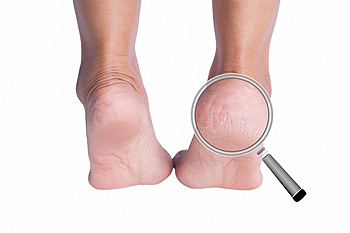 This is much less likely to happen in children than adults because kid’s feet are so tender and mechanical foot factors are not at play yet. However, there are situations where children can have cracked heels. Usually, a child has something abnormal going on with their immune system which impacts the functioning of their skin. Cracks can happen with disorders of nervous system regulation or hormones. Cracked heels can come on with stress, neuropsychic overstrain, or insufficient nutrition, particularly with a deficiency in vitamins B, A, and/or E. If cracks appear, it is usually during a transition period, such as adapting to going to school, the onset of adolescence, or from shock (like in the divorce of parents). Skin can become dry and flaky in response to stressors. As with adults, cracks in children’s feet need attention so as not to become infected and turn into wounds. If your child has cracked heels, protect the heel by covering it with a band-aid, and it is suggested you then take him or her to a podiatrist for appropriate treatment.
This is much less likely to happen in children than adults because kid’s feet are so tender and mechanical foot factors are not at play yet. However, there are situations where children can have cracked heels. Usually, a child has something abnormal going on with their immune system which impacts the functioning of their skin. Cracks can happen with disorders of nervous system regulation or hormones. Cracked heels can come on with stress, neuropsychic overstrain, or insufficient nutrition, particularly with a deficiency in vitamins B, A, and/or E. If cracks appear, it is usually during a transition period, such as adapting to going to school, the onset of adolescence, or from shock (like in the divorce of parents). Skin can become dry and flaky in response to stressors. As with adults, cracks in children’s feet need attention so as not to become infected and turn into wounds. If your child has cracked heels, protect the heel by covering it with a band-aid, and it is suggested you then take him or her to a podiatrist for appropriate treatment.
Cracked heels are unsightly and can cause further damage to your shoes and feet. If you have any concerns, contact Stephen Boykins, DPM from SoCal Podiatry, P.C.. Our doctor can provide the care you need to keep you pain-free and on your feet.
Cracked Heels
Cracked heels appear unappealing and can make it harder for you walk around in sandals. Aside from looking unpleasant, cracked heels can also tear stockings, socks, and wear out your shoes. There are several methods to help restore a cracked heel and prevent further damage.
How Do You Get Them?
Dry skin is the number one culprit in creating cracked heels. Many athletes, walkers, joggers, and even swimmers suffer from cracked heels. Age and skin oil production play a role to getting cracked heels as well.
Promote Healing
Over the counter medicines can help, especially for those that need instant relief or who suffer from chronic dry feet.
Wear Socks – Wearing socks with medicated creams helps lock in moisture.
Moisturizers – Applying both day and night will help alleviate dryness which causes cracking.
Pumice Stones – These exfoliate and remove dead skin, which allows for smoother moisturizer application and better absorption into the skin.
Change in Diet
Eating healthy with a well-balanced diet will give the skin a fresh and radiant look. Your body responds to the kinds of food you ingest. Omega-3 fatty acids and zinc supplements can also revitalize skin tissue.
Most importantly, seek professional help if unsure how to proceed in treating cracked heels. A podiatrist will help you with any questions or information needed.
If you have any questions, please feel free to contact our offices located in Downey and Moreno Valley, CA . We offer the newest diagnostic and treatment technologies for all your foot care needs.
When an Ingrown Toenail Becomes Dangerous
I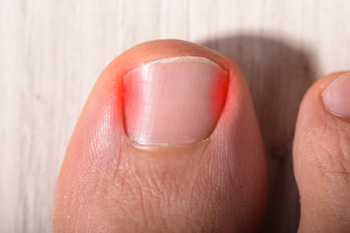 ngrown toenails can occur in individuals of all ages when the side of the nail digs into the skin. This condition is most prevalent in one’s big toe and will cause pain, discomfort, and redness where the ingrown nail meets the skin. Although the causes of ingrown toenails are varied, this condition frequently occurs due to improper nail care. If a toenail is cut too short, for example, the skin on the side of the nail can grow over top of the nail, eventually making it ingrown. Ingrown toenails can also develop when a toenail completely falls off following a serious foot injury or when the nail is severely ripped or misshapen. Some ingrown toenails—notably, milder ones—do not require immediate medical attention. However, making yourself aware of ingrown toenails is important to maintaining healthy feet because this condition can quickly become dangerous. Ingrown toenails may sometimes become infected, producing pus, swelling, warmness, and even unpleasant odors where the ingrown nail meets the skin. Letting such an infection go untreated may exacerbate the condition and the pain felt in the toenail. Upon receiving proper medical attention, your ingrown nail may be cared for by draining pus or removing sections of the ingrown nail. It is suggested you consult with your podiatrist if you feel an ingrown toenail is getting serious.
ngrown toenails can occur in individuals of all ages when the side of the nail digs into the skin. This condition is most prevalent in one’s big toe and will cause pain, discomfort, and redness where the ingrown nail meets the skin. Although the causes of ingrown toenails are varied, this condition frequently occurs due to improper nail care. If a toenail is cut too short, for example, the skin on the side of the nail can grow over top of the nail, eventually making it ingrown. Ingrown toenails can also develop when a toenail completely falls off following a serious foot injury or when the nail is severely ripped or misshapen. Some ingrown toenails—notably, milder ones—do not require immediate medical attention. However, making yourself aware of ingrown toenails is important to maintaining healthy feet because this condition can quickly become dangerous. Ingrown toenails may sometimes become infected, producing pus, swelling, warmness, and even unpleasant odors where the ingrown nail meets the skin. Letting such an infection go untreated may exacerbate the condition and the pain felt in the toenail. Upon receiving proper medical attention, your ingrown nail may be cared for by draining pus or removing sections of the ingrown nail. It is suggested you consult with your podiatrist if you feel an ingrown toenail is getting serious.
Ingrown toenails can become painful if they are not treated properly. For more information about ingrown toenails, contact Stephen Boykins, DPM of SoCal Podiatry, P.C.. Our doctor can provide the care you need to keep you pain-free and on your feet.
Ingrown Toenails
Ingrown toenails occur when a toenail grows sideways into the bed of the nail, causing pain, swelling, and possibly infection.
Causes
- Bacterial infections
- Improper nail cutting such as cutting it too short or not straight across
- Trauma to the toe, such as stubbing, which causes the nail to grow back irregularly
- Ill-fitting shoes that bunch the toes too close together
- Genetic predisposition
Prevention
Because ingrown toenails are not something found outside of shoe-wearing cultures, going barefoot as often as possible will decrease the likeliness of developing ingrown toenails. Wearing proper fitting shoes and using proper cutting techniques will also help decrease your risk of developing ingrown toenails.
Treatment
Ingrown toenails are a very treatable foot condition. In minor cases, soaking the affected area in salt or antibacterial soaps will not only help with the ingrown nail itself, but also help prevent any infections from occurring. In more severe cases, surgery is an option. In either case, speaking to your podiatrist about this condition will help you get a better understanding of specific treatment options that are right for you.
If you have any questions please feel free to contact our offices located in Downey and Moreno Valley, CA . We offer the newest diagnostic and treatment technologies for all your foot and ankle needs.
Ingrown Toenails
An ingrown toenail is a nail that has curved downward and grown into the skin. This typically occurs at either the nail borders or the sides of the nail. As a result, pain, redness, swelling, and warmth may occur in the toe. If a break in the skin forms due to the ingrown nail, bacteria may enter and cause an infection in the area; this is typically characterized by a foul odor and drainage.
Ingrown toenails have multiple reasons for developing. In many instances, the condition is a result of genetics and is inherited. The most common cause, however, is improper trimming; cutting the toenails too short forces the skin beside the nail to fold over. An ingrown toenail can also develop due to trauma, such as stubbing the toe, having an object fall on the toe, or participating in activities that involve repeated kicking or running. Wearing shoes that are too tight or too short can also cause ingrown toenails.
Treatment for an ingrown toenail varies between patients and the severity of the condition. In most cases, it is best to see your podiatrist for thorough and proper treatment. After examining your toe, your podiatrist may prescribe oral antibiotics to clear the infection if one is present. Surgical removal of either a portion of the nail or the entire nail may also be considered. In some cases, complete removal or destruction of the nail root may be required. Most patients who undergo nail surgery experience minimal pain afterward and can return to normal activity the following day.
Ingrown toenails can be prevented with proper nail trimming and by avoiding improper-fitting shoes. When cutting the toenails, be sure that you are cutting in a straight line and avoid cutting them too short. Shoes should not be too short or tight in the toe box.
Arthritis Can Affect the Feet, Toes, and Ankles
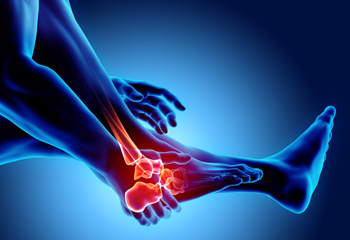
Arthritis can have painful effects on the feet, toes, and ankles. Some of the more common types of arthritis are described here. Osteoarthritis (OA) mainly affects the first metatarsal joint connecting the big toe to the foot, as well as the midfoot and ankle. It is a wear and tear arthritis because it causes cartilage in the joints to wear down, leading the bones to rub together. Rheumatoid arthritis (RA) is an autoimmune disease where the immune system attacks the lining of the joints, including the ankle, heels, midfoot, and forefoot. Over time, the damage can lead to joint deformity and/or disability. Gout is an inflammatory type of arthritis caused by uric acid build up and crystallization in joints, often in the big toe of the foot. Psoriatic arthritis (PsA) is also an inflammatory arthritis that can happen to those with psoriasis. It can affect the joints in the ankle as well as ligaments and tendons in the foot. Anyone with any type of arthritis can experience foot involvement, which can make it hard to walk and perform activities of daily life. While arthritis has no cure, treatment options exist to slow the progression of the disease and relieve symptoms. If you experience the pain of arthritis in your feet and ankles, seek the counsel of a podiatrist who can help you manage pain, stay active, and lead a fulfilling life.
Arthritis can be a difficult condition to live with. If you are seeking treatment, contact Stephen Boykins, DPM from SoCal Podiatry, P.C.. Our doctor can provide the care you need to keep you pain-free and on your feet.
Arthritic Foot Care
Arthritis is a term that is commonly used to describe joint pain. The condition itself can occur to anyone of any age, race, or gender, and there are over 100 types of it. Nevertheless, arthritis is more commonly found in women compared to men, and it is also more prevalent in those who are overweight. The causes of arthritis vary depending on which type of arthritis you have. Osteoarthritis for example, is often caused by injury, while rheumatoid arthritis is caused by a misdirected immune system.
Symptoms
- Swelling
- Pain
- Stiffness
- Decreased Range of Motion
Arthritic symptoms range in severity, and they may come and go. Some symptoms stay the same for several years but could potentially get worse with time. Severe cases of arthritis can prevent its sufferers from performing daily activities and make walking difficult.
Risk Factors
- Occupation – Occupations requiring repetitive knee movements have been linked to osteoarthritis
- Obesity – Excess weight can contribute to osteoarthritis development
- Infection – Microbial agents can infect the joints and trigger arthritis
- Joint Injuries – Damage to joints may lead to osteoarthritis
- Age – Risk increases with age
- Gender –Most types are more common in women
- Genetics – Arthritis can be hereditary
If you suspect your arthritis is affecting your feet, it is crucial that you see a podiatrist immediately. Your doctor will be able to address your specific case and help you decide which treatment method is best for you.
If you have any questions, please feel free to contact our offices located in Downey and Moreno Valley, CA . We offer the newest diagnostic and treatment technologies for all your foot care needs.
How to Care for Your Arthritic Foot
Arthritis is an inflammation of the joints and it can occur at any joint in the body, especially in the foot. It generally effects those who are older, however, it can occur at any age. Although there are many different forms of arthritis, there are three main types that occur in the foot. The three types are osteoarthritis, rheumatoid arthritis, and gout.
The primary cause of osteoarthritis is aging. As you age, cartilage degenerates around the joints which causes friction and pain. Obesity can cause osteoarthritis through mechanical stress. Injuries that damage joints can increase the probability as well. Finally, a family history of osteoarthritis can also increase chances of having it.
Rheumatoid arthritis occurs when the immune system attacks the joint linings and weakens them over a long time. While there is no known cause of rheumatoid arthritis, obesity and smoking can increase your chances of getting it. Women are also more likely to get it than men.
Gout is a form of arthritis that occurs when there is too much uric acid in your blood and painful crystals form in your joints. Men are more likely to have gout than women. People who are obese or drink alcohol often are also more likely to develop gout. Furthermore, having diabetes, heart disease, high blood pressure, high cholesterol, gastric bypass surgery or a family history of gout may increase your likelihood of developing the condition.
Symptoms of arthritis include pain, stiffness, swelling in the joints. These symptoms can make it harder and more painful to walk. Physical activity can increase pain and discomfort. Furthermore, joint pain can worsen throughout the day for osteoarthritis. Gout attacks generally last several days with the first few being the worst.
Diagnosis of gout includes either a joint fluid test or a blood test. X-ray imaging can detect osteoarthritis but not gout. On the other hand, there is no blood test for osteoarthritis. Rheumatoid arthritis is difficult to diagnosis. Doctors utilize family and personal medical history, a physical examination, and antibody blood tests to determine if you have rheumatoid arthritis.
Treatment varies for the different kinds of arthritis. Anti-inflammatory medication or steroids can help reduce pain from inflammation of the joints. Changing shoe types can help with some symptoms. Wider shoes can help with discomfort from gout and osteoarthritis. High heels should be avoided. Shoes with proper arch support and that take pressure off the ball of the foot can help with rheumatoid arthritis. Drinking lots of water can also help rid uric acid from the blood. Losing weight, improving your diet, and limiting alcohol and smoking can also help prevent or lessen the symptoms of arthritis.
If you are having trouble walking or pain in your feet, see a podiatrist to check if you have arthritis.
Stretches Can Be Added to Everyday Foot Care Practices
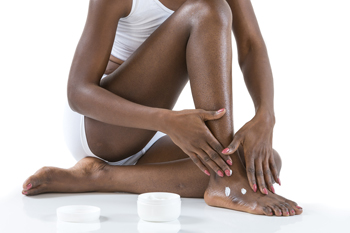
Effective everyday foot care begins with washing and drying the feet thoroughly. This can be followed by applying a good moisturizer which may help to prevent cracked heels and skin. There are many people who perform a weekly foot soak that may aid in keeping the cuticles soft. When the toenails are trimmed properly, foot conditions like ingrown toenails can possibly be prevented. This is done by trimming the toenails straight across to allow the toenails to grow up instead of into the surrounding skin. When gentle foot stretches are incorporated into your daily routine the benefits can reach the overall body. Additionally, there are specific toe stretches that can be performed. This is accomplished by sitting on the floor and wrapping a towel around the toes and gently pulling them toward you. All of these practices are designed to help the feet feel better. If you would like additional information on how to practice everyday foot care, please consult with a podiatrist.
Everyday foot care is very important to prevent infection and other foot ailments. If you need your feet checked, contact Stephen Boykins, DPM from SoCal Podiatry, P.C.. Our doctor can provide the care you need to keep you pain-free and on your feet.
Everyday Foot Care
Often, people take care of their bodies, face and hair more so than they do for their feet. But the feet are a very important aspect of our bodies, and one that we should pay more attention to. Without our feet, we would not be able to perform most daily tasks.
It is best to check your feet regularly to make sure there are no new bruises or cuts that you may not have noticed before. For dry feet, moisturizer can easily be a remedy and can be applied as often as necessary to the affected areas. Wearing shoes that fit well can also help you maintain good foot health, as well as making it easier to walk and do daily activities without the stress or pain of ill-fitting shoes, high heels, or even flip flops. Wearing clean socks with closed shoes is important to ensure that sweat and bacteria do not accumulate within the shoe. Clean socks help to prevent Athlete’s foot, fungi problems, bad odors, and can absorb sweat.
If you have any questions please feel free to contact our offices located in Downey and Moreno Valley, CA . We offer the newest diagnostic and treatment technologies for all your foot and ankle needs.
Every Day Foot Care
Our feet are important in our everyday lives. The problem is that we tend to neglect them. When this becomes a habit, it can cause significant trouble. Ignoring foot problems can mean pain, limited mobility, and expensive doctor's visits. On the other hand, if feet are cared for and looked after regularly, they will perform without pain or complication.
Routine hygiene is the most basic way to care for the feet. Wash and dry them thoroughly daily. Remember to get between the toes and keep the toenails trimmed and short. If the feet feel dry or there are signs of dryness or cracking, use a moisturizer designed for the feet.
When using moisturizer on the feet, try to avoid applying between the toes. If cream or lotion sits too long, they can cause fungal and bacterial growth. When moisturizer is used between the toes, it can also cause the skin to soften too much.
Shoes are also an important aspect of foot care. When one is picking out shoes, make sure they are the correct size. Shoes need to be snug, but not too tight. On the other hand, if shoes are too loose they can cause foot problems as well. It is highly recommended that shopping for new shoes be done later in the day. The reason for this is that the feet will have settled and swelled to their full size by then. To keep your feet at their most healthy, avoid wearing high heels or flip flops too often. Instead, choose shoes that are good for your feet. Good shoes pad the soles of your feet and support the arches and ankles.
Socks should also be worn daily with closed-toe shoes. They may feel hot during the summer months, but they absorb sweat and moisture off the feet. Without socks, the build-up of sweat in a closed-toe shoe can cause fungal problems and athlete's foot.
The best thing to remember in every day foot care is that shoes do make a difference. If you spend a lot of time on your feet, make sure that your shoes show no signs of wear. Shoes should offer ample support for the arches and the overall foot. Additionally, try to make foot cleaning and maintenance a daily habit. If you keep these things in mind, your feet will stay healthy and safe.
Several Reasons for Cuboid Syndrome to Occur
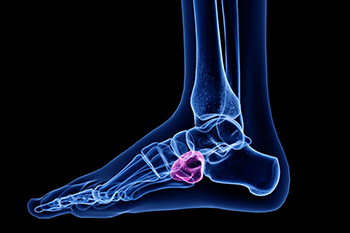
Patients that have cuboid syndrome often experience an injury that can lead to this condition. It occurs when the surrounding ligaments of the cuboid bone become inflamed, which can cause pain and discomfort. The cuboid bone is found on the outside of the foot, and is one of the seven tarsal bones. This foot condition can be common among athletes and ballet dancers, and can be the result of repetitive movement. The cuboid bone helps to stabilize the foot, and enables comfortable walking. Additionally, it aids in the ability to point and flex, and this is necessary in completing daily activities. It can become injured for a variety of reasons. These can include enduring a severe foot injury, having a sprained ankle, or possibly from running barefoot. People who are overweight or wear shoes that do not fit correctly may be prone to developing cuboid syndrome. Mild relief may be found when the affected foot is rested, and this may help to heal the tissues surrounding the cuboid bone. If you have pain on the outside of your foot, please schedule an appointment with a podiatrist who can properly diagnose and treat cuboid syndrome.
Cuboid syndrome, also known as cuboid subluxation, occurs when the joints and ligaments near the cuboid bone in the foot become torn. If you have cuboid syndrome, consult with Stephen Boykins, DPM from SoCal Podiatry, P.C.. Our doctor will assess your condition and provide you with quality foot and ankle treatment.
Cuboid syndrome is a common cause of lateral foot pain, which is pain on the outside of the foot. The condition may happen suddenly due to an ankle sprain, or it may develop slowly overtime from repetitive tension through the bone and surrounding structures.
Causes
The most common causes of cuboid syndrome include:
- Injury – The most common cause of this ailment is an ankle sprain.
- Repetitive Strain – Tension placed through the peroneus longus muscle from repetitive activities such as jumping and running may cause excessive traction on the bone causing it to sublux.
- Altered Foot Biomechanics – Most people suffering from cuboid subluxation have flat feet.
Symptoms
A common symptom of cuboid syndrome is pain along the outside of the foot which can be felt in the ankle and toes. This pain may create walking difficulties and may cause those with the condition to walk with a limp.
Diagnosis
Diagnosis of cuboid syndrome is often difficult, and it is often misdiagnosed. X-rays, MRIs and CT scans often fail to properly show the cuboid subluxation. Although there isn’t a specific test used to diagnose cuboid syndrome, your podiatrist will usually check if pain is felt while pressing firmly on the cuboid bone of your foot.
Treatment
Just as the range of causes varies widely, so do treatments. Some more common treatments are ice therapy, rest, exercise, taping, and orthotics.
If you have any questions, please feel free to contact our offices located in Downey and Moreno Valley, CA . We offer the newest diagnostic and treatment technologies for all your foot care needs.
Cuboid Syndrome
Cuboid syndrome mostly affects athletes, although it can affect non-athletes too. It is also known as cuboid subluxation or cuboid fault syndrome. This condition occurs when joints and ligaments near the cuboid bone of the foot are damaged, or when the cuboid bone itself is dislodged from its natural position. It is usually marked by pain on the outer side of the foot, which may be persistent or may come and go. Cuboid syndrome can be difficult to diagnose unless it becomes severe and more noticeable. Your doctor will likely ask questions about when the pain began and how long it has been present, and will put pressure on the cuboid bone to determine if that area is the origin of the pain.
Causes of Cuboid Syndrome
- Any repetitive stresses placed on the foot due to athletic activities are a common cause of cuboid syndrome.
- Although it develops over time, it is possible that this syndrome can occur all of sudden due to a single event or injury.
- Over-pronation can exacerbate the condition if not corrected.
Disagreements Amongst Podiatrists Regarding Cuboid Syndrome
- Some refer to it as the dislocation of the calcaneal-cuboid joint only.
- Other podiatrists see it as an injury of the ligaments located nearby, which also involves the cuboid bone.
It is very important that when you experience any kind of pain on the side of your foot, you should seek medical care right away. If a subluxed cuboid is caught early, your feet may respond well to the treatment, and you can get back into sports or other activities again as soon as the pain subsides.





